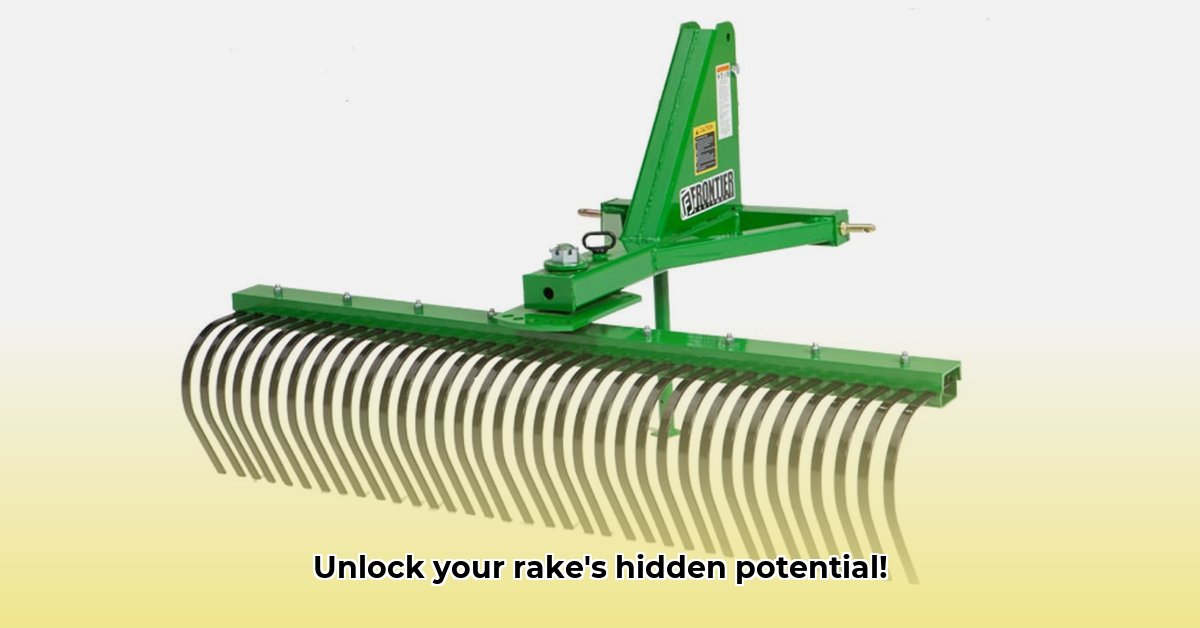
3-Point Hitch Rakes from Tractor Supply: Your Guide to Efficient and Sustainable Haymaking
Harvesting hay efficiently and sustainably is crucial for modern farming. A 3-point hitch rake from Tractor Supply can significantly improve your operation, reducing labor, fuel consumption, and minimizing soil compaction. This comprehensive guide explores the various types of rakes available, provides practical advice on choosing the right one for your needs, and offers essential tips for safe operation and maintenance. We'll also delve into the environmental benefits of utilizing this equipment for sustainable agricultural practices. For more information on 3-point hitches, check out this helpful resource.
Understanding Your Options: Tractor Supply's 3-Point Hitch Rake Selection
Tractor Supply offers a diverse range of 3-point hitch rakes, each designed to suit specific needs and farming conditions. Choosing the right one hinges on carefully evaluating several key factors.
Working Width: Optimizing Coverage and Efficiency
Rake width directly impacts ground coverage per pass. Wider rakes are faster for large fields but demand more powerful tractors. Narrower rakes excel in smaller, confined spaces, prioritizing maneuverability. Consider your field size and tractor capacity when making this decision. "A wider rake may seem faster, but it could be working against you if your tractor doesn't have the power to handle it," advises Dr. Emily Carter, Agricultural Engineering Professor at State University. "Efficiency isn't just about speed; it's about optimized resource use."
Tine Type: Balancing Gentleness with Durability
The tines are the critical components that gather the hay. Two primary types exist:
- Steel Tines: Durable and suitable for coarser hay or challenging conditions.
- Spring Tines: Gentler, minimizing leaf loss and preserving hay quality, particularly beneficial for delicate crops.
The choice depends on your specific hay type and desired quality. Spring tines, while potentially more expensive, often lead to higher-quality hay, which commands a better price in the market. This highlights the importance of considering the long-term economic benefits alongside the immediate purchase cost.
Rake Style: Rotary vs. Wheel – A Matter of Technique
Two main styles dominate the market:
- Rotary Rakes: Utilize a rotating drum to gather hay efficiently, creating a dense windrow.
- Wheel Rakes: Employ rotating tines, often considered better for uneven terrain and capable of handling various hay densities.
The best choice depends on your terrain and hay conditions. Rotary rakes excel in smoother fields and provide a consistent windrow, while wheel rakes handle uneven terrain better. Each style has its advantages and drawbacks, and the decision should be based on your specific needs.
Capacity: Matching Rake Size to Harvest Volume
Rake capacity dictates how much hay it can hold before needing to be unloaded. Larger capacities reduce trips but require more powerful tractors. Assess your typical hay yields and field size to determine the appropriate capacity. Overestimating can lead to unnecessary fuel consumption and potential damage to the equipment, while underestimating will lead to increased labor and time spent on the task.
Choosing the Right Rake for Your Farm: A Tailored Approach
Before purchasing, carefully evaluate your farm's unique characteristics:
| Factor | Considerations |
|---|---|
| Field Size & Shape | Large, open fields require wider rakes; narrow, uneven fields demand maneuverability. |
| Hay Type & Yield | Hay type (alfalfa, clover, etc.) and yield influence capacity requirements. |
| Tractor Horsepower | Match the rake's horsepower requirements to your tractor's capabilities. |
| Budget & Maintenance | Consider both initial cost and long-term maintenance expenses. |
| Terrain | Uneven terrain might require a rake specifically designed for such conditions (e.g., wheel rake for hilly fields). |
Safe Operation and Maintenance: Extending Equipment Lifespan and Ensuring Safety
Always consult the owner's manual before operating your rake. Safe and effective operation includes:
- Hitching: Securely attach the rake to your tractor's 3-point hitch, meticulously following the manufacturer's instructions. Double-check all connections.
- Adjustments: Adjust height and tine angle for optimal performance based on terrain and hay conditions. Experiment to find the sweet spot.
- Raking Technique: Maintain a moderate speed, avoiding sharp turns.
- Maintenance: Regularly inspect for wear and tear; lubricate moving parts; promptly replace worn or damaged components.
Sustainable Haymaking: Environmental Benefits and Long Term Impact
Using a 3-point hitch rake significantly contributes to sustainable farming:
- Reduced Soil Compaction: Minimizes soil disturbance, preserving soil structure and promoting healthy plant growth.
- Improved Efficiency: Increases haymaking efficiency, reducing labor, fuel, and operational costs.
- Better Hay Quality: Gentle handling minimizes leaf loss, resulting in higher-quality hay.
- Resource Optimization: Efficient processes optimize water and fertilizer usage.
Mastering Your Rake for Optimal Results
Mastering your 3-point hitch rake enhances your farming efficiency, reduces environmental impact, and boosts profitability. Regular maintenance, proper technique, and a thorough understanding of your equipment are keys to success. Remember, a well-maintained rake translates to less downtime, fewer expenses, and more time focused on other crucial aspects of your farm.
How to Reduce the Environmental Impact of Farm Equipment Lifecycle
Key Takeaways:
- Optimizing tractor implement use minimizes fuel consumption and soil compaction.
- Proper maintenance extends equipment lifespan, reducing waste.
- Careful equipment selection is crucial for minimizing environmental impact.
- Sustainable farming practices significantly reduce the overall environmental footprint.
This guide has provided a comprehensive overview of using Tractor Supply's 3-point hitch rakes for efficient and sustainable farming. By understanding the various factors involved in selecting, operating, and maintaining these tools, farmers can significantly improve their operations while minimizing their environmental footprint. Remember that sustainable practices are not just about the equipment itself but also about the overall approach to farming.